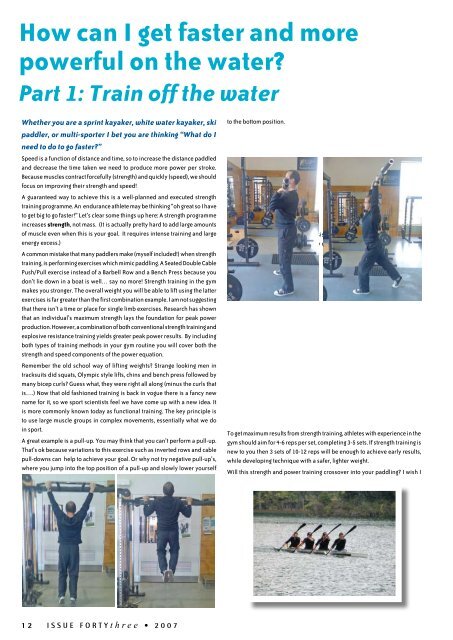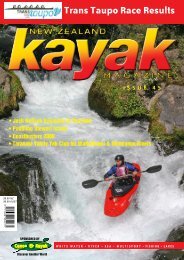Be in to win a $500.00 gift VouCher - Canoe & Kayak
Be in to win a $500.00 gift VouCher - Canoe & Kayak
Be in to win a $500.00 gift VouCher - Canoe & Kayak
- No tags were found...
Create successful ePaper yourself
Turn your PDF publications into a flip-book with our unique Google optimized e-Paper software.
How can I get faster and morepowerful on the water?Part 1: Tra<strong>in</strong> off the waterWhether you are a spr<strong>in</strong>t kayaker, white water kayaker, skipaddler, or multi-sporter I bet you are th<strong>in</strong>k<strong>in</strong>g “What do Ineed <strong>to</strong> do <strong>to</strong> go faster?”Speed is a function of distance and time, so <strong>to</strong> <strong>in</strong>crease the distance paddledand decrease the time taken we need <strong>to</strong> produce more power per stroke.<strong>Be</strong>cause muscles contract forcefully (strength) and quickly (speed), we shouldfocus on improv<strong>in</strong>g their strength and speed!A guaranteed way <strong>to</strong> achieve this is a well-planned and executed strengthtra<strong>in</strong><strong>in</strong>g programme. An endurance athlete may be th<strong>in</strong>k<strong>in</strong>g “oh great so I have<strong>to</strong> get big <strong>to</strong> go faster!” Let’s clear some th<strong>in</strong>gs up here: A strength programme<strong>in</strong>creases strength, not mass. (It is actually pretty hard <strong>to</strong> add large amountsof muscle even when this is your goal. It requires <strong>in</strong>tense tra<strong>in</strong><strong>in</strong>g and largeenergy excess.)A common mistake that many paddlers make (myself <strong>in</strong>cluded!) when strengthtra<strong>in</strong><strong>in</strong>g, is perform<strong>in</strong>g exercises which mimic paddl<strong>in</strong>g. A Seated Double CablePush/Pull exercise <strong>in</strong>stead of a Barbell Row and a <strong>Be</strong>nch Press because youdon’t lie down <strong>in</strong> a boat is well… say no more! Strength tra<strong>in</strong><strong>in</strong>g <strong>in</strong> the gymmakes you stronger. The overall weight you will be able <strong>to</strong> lift us<strong>in</strong>g the latterexercises is far greater than the first comb<strong>in</strong>ation example. I am not suggest<strong>in</strong>gthat there isn’t a time or place for s<strong>in</strong>gle limb exercises. Research has shownthat an <strong>in</strong>dividual’s maximum strength lays the foundation for peak powerproduction. However, a comb<strong>in</strong>ation of both conventional strength tra<strong>in</strong><strong>in</strong>g andexplosive resistance tra<strong>in</strong><strong>in</strong>g yields greater peak power results. By <strong>in</strong>clud<strong>in</strong>gboth types of tra<strong>in</strong><strong>in</strong>g methods <strong>in</strong> your gym rout<strong>in</strong>e you will cover both thestrength and speed components of the power equation.Remember the old school way of lift<strong>in</strong>g weights? Strange look<strong>in</strong>g men <strong>in</strong>tracksuits did squats, Olympic style lifts, ch<strong>in</strong>s and bench press followed bymany bicep curls? Guess what, they were right all along (m<strong>in</strong>us the curls thatis….) Now that old fashioned tra<strong>in</strong><strong>in</strong>g is back <strong>in</strong> vogue there is a fancy newname for it, so we sport scientists feel we have come up with a new idea. Itis more commonly known <strong>to</strong>day as functional tra<strong>in</strong><strong>in</strong>g. The key pr<strong>in</strong>ciple is<strong>to</strong> use large muscle groups <strong>in</strong> complex movements, essentially what we do<strong>in</strong> sport.A great example is a pull-up. You may th<strong>in</strong>k that you can’t perform a pull-up.That’s ok because variations <strong>to</strong> this exercise such as <strong>in</strong>verted rows and cablepull-downs can help <strong>to</strong> achieve your goal. Or why not try negative pull-up’s,where you jump <strong>in</strong><strong>to</strong> the <strong>to</strong>p position of a pull-up and slowly lower yourself<strong>to</strong> the bot<strong>to</strong>m position.A great example of an explosive resistance exercise is a split jerk. This is amodified Olympic lift, performed by driv<strong>in</strong>g a barbell above the head us<strong>in</strong>gthe entire body.To get maximum results from strength tra<strong>in</strong><strong>in</strong>g, athletes with experience <strong>in</strong> thegym should aim for 4-6 reps per set, complet<strong>in</strong>g 3-5 sets. If strength tra<strong>in</strong><strong>in</strong>g isnew <strong>to</strong> you then 3 sets of 10-12 reps will be enough <strong>to</strong> achieve early results,while develop<strong>in</strong>g technique with a safer, lighter weight.Will this strength and power tra<strong>in</strong><strong>in</strong>g crossover <strong>in</strong><strong>to</strong> your paddl<strong>in</strong>g? I wish I12 ISSUE FORTYthree • 2 0 0 7
















